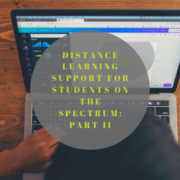Distance Learning Support for Students on the Spectrum: Part II
In part one, we discussed the importance of implementing strategies to help build strong relationships with students remotely. This is no easy task, but establishing a strong sense of community is a critical aspect of success for students with autism—they must feel connected, supported, and heard in order to truly meet their academic potential. In parts two and three, we will discuss additional tools and methods for supporting students on the spectrum remotely, including consistency and specificity.
Consistency is key
For students on the spectrum, change might throw them for a loop on a greater level. As if the changes that happened this past year were not enough, the sudden switch to virtual schooling undoubtedly shook many students. Now that many students, educators and families have settled into somewhat of a routine for remote instruction, it is essential to maintain those procedures and expectations as much as humanly possible. Any abrupt changes or inconsistencies bring unnecessary stress into students’ lives, especially those students with autism, who tend to thrive in sameness, continuity, and routine. Below are some simple suggestions to help keep things consistent for your students who depend on those measures and routines:
- When setting up a new module for each new week or unit for your class, click the three dots to edit and set every new module to be “moved” to the top. This way, every time students want to find the most recent course materials, they can see everything at the very top of the page when clicking into their modules—no more scrolling!
- Use the same procedure for your warm-up every day. I prefer to keep it casual by asking students some sort of activator or daily question on the shared intro slide so that they see it immediately when they enter the Zoom. I ask students to respond in the chat every day so that I can use their answers as starting points for discussion, as well as for taking attendance.
- Organize assignments clearly and consistently in Canvas. For example, if the assignment is called “Written Response: Night chapter 1” on the Google slides, be sure to title it exactly the same way in your assignments tab on Canvas. As teachers, we can of course keep track of our various assignment names. But for students, consistency will remove the second guessing when it comes to locating and completing their work.
- Consider setting up due dates for weekly homework assignments that remain the same throughout the semester. For instance, if you are reading a novel and plan to track students’ reading and comprehension, explain that their novel notes or annotations for the week’s chapters will be due every Friday. Keeping that running Friday due date will help ensure that students are organized and better prepared to mentally or physically plan out their homework tasks for the week.
- Consider setting up individual check-in times for students with autism on a weekly or biweekly schedule. Students on the spectrum may need additional one-to-one teacher support that extends beyond the allotted weekly office hour. Ask students if they would like more assistance and when in their weekly schedule they could plan to chat for 15 minutes or so. Assure them that this is not a punishment or a mandatory check-in, but rather an opportunity to ask individual questions, review assignments and feedback, and gain clarity on anything. Keep the check-ins on the same day at the same time every two weeks and send out calendar reminders. Teachers can also encourage parents to pop in on these check-ins as well.













